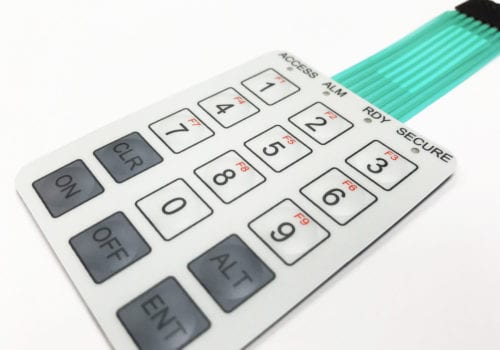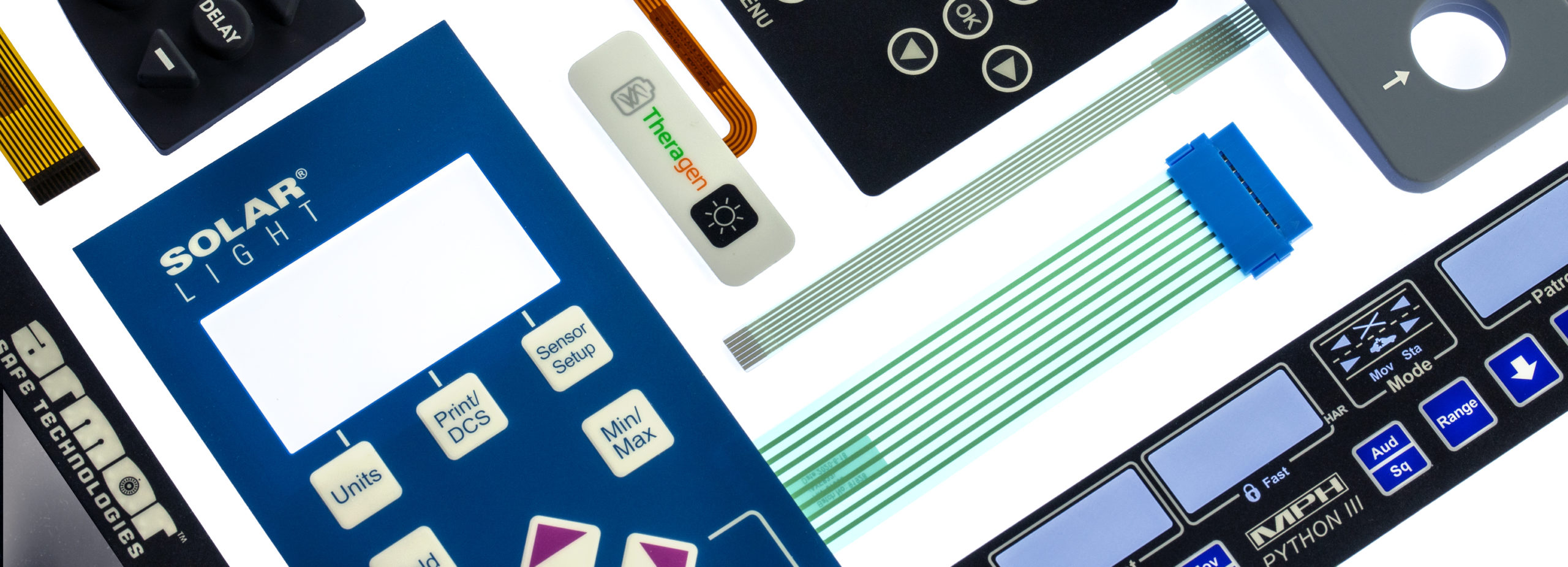Top companies often choose a skilled membrane switch manufacturer to deliver reliable results.
Top companies often choose a skilled membrane switch manufacturer to deliver reliable results.
Blog Article
All About Membrane Change: Recognizing Its Layout and Capability
When you assume regarding the control interfaces in modern-day tools, membrane layer switches typically enter your mind. These elements are greater than just buttons; they mix style and functionality effortlessly. Comprehending exactly how they work and what makes them efficient can alter your perspective on day-to-day electronic devices. There are nuances to their layout and performance that you might not be aware of. Let's explore what sets membrane layer changes aside from various other control systems.
What Are Membrane Layer Buttons?

Their seamless nature makes them easy to tidy and immune to dirt and dampness, an important feature in several settings. Membrane layer buttons can likewise be personalized concerning form, size, and graphics, enabling makers to produce unique user interfaces tailored to details products. Plus, they're lightweight and slim, which assists in reducing the total bulk of tools. On the whole, membrane layer switches play a substantial role in improving user experience across a broad variety of applications.
How Membrane Layer Changes Job
When you press a secret on a membrane switch, it triggers an uncomplicated yet efficient device. The leading layer, commonly made of adaptable material, lowers onto a conductive layer beneath it. This activity bridges the space in between conductive traces, finishing an electrical circuit. As quickly as the circuit closes, it sends a signal to the tool's controller, which interprets your input.
You'll notice that the responsive comments varies based on the button style, offering either a soft click or a much more obvious action. Once you release the trick, the membrane returns to its initial position, reopening the circuit and quiting the signal. This procedure happens practically instantly, making certain a responsive customer experience.
Membrane layer buttons are popular as a result of their longevity and resistance to dirt and moisture, making them excellent for different applications, from house home appliances to clinical gadgets. Comprehending this operation aids you value their widespread use.
Secret Parts of Membrane Buttons
Comprehending the essential components of membrane layer buttons is basic for comprehending their performance and layout. The protective layer guards against ecological variables and put on, extending the button's life expectancy. By understanding these elements, you'll obtain understanding into exactly how membrane layer switches over operate and their importance in different applications.
Materials Made Use Of in Membrane Switch Design
The performance and longevity of membrane layer switches over greatly depend upon the products made use of in their design. You normally run into polyester and polycarbonate as primary substratums because of their excellent stamina and flexibility. These products stand up to scrapes and chemicals, making them optimal for requiring atmospheres.
The conductive layers typically make use of silver or carbon, selected for their dependability and conductivity. membrane switch manufacturer. Silver gives superior performance, while carbon is an economical choice. For the overlay, you could think about a matte or shiny finish, depending upon your aesthetic requirements and customer experience
Make specific to select adhesives that hold up against environmental elements like temperature and moisture. Picking the right materials will assure your membrane button stands the examination of time.
Design Factors To Consider for Membrane Layer Buttons
While developing membrane buttons, it's important to consider different aspects that influence their functionality and my site customer experience. Begin by concentrating on the format and button size; ensure they're user-friendly and easy to browse. Think about the responsive feedback you wish to supply-- will individuals require an obvious click or a softer touch? In addition, think of the materials you'll utilize, as they'll impact toughness and aesthetics.
Don't forget the graphic design; clear labeling and color contrast are significant for exposure. Verify your design accommodates environmental aspects, like moisture or temperature level variations, which might influence efficiency. Remember the relevance of testing models with actual customers to collect comments and make required changes. This repetitive process aids you improve the design, verifying it fulfills both functional and aesthetic needs effectively. By meticulously thinking about these components, you'll produce a membrane layer button that boosts functionality and complete satisfaction.
Applications of Membrane Switches
Membrane switches are functional components found in different applications, from commercial devices to consumer electronic devices. You'll see their effect in equipments that require durable interfaces and in devices that gain from smooth styles. Understanding these applications aids you value the capability and usefulness of membrane layer switches in everyday technology.
Industrial Tools Use
When you're aiming to improve the performance of industrial tools, membrane buttons offer a dependable service that combines visit homepage resilience with user-friendly design. These switches are perfect for severe settings, supplying resistance to dirt, wetness, and chemicals. You'll discover them in control panels for making devices, cooling and heating systems, and clinical tools, where accuracy and responsiveness are crucial. Their low profile means they fit effortlessly into numerous devices, conserving important area while preserving simplicity of use. With adjustable graphics and backlighting alternatives, you can develop an user-friendly user interface for operators, enhancing efficiency and safety and security. Plus, their long life-span decreases maintenance expenses, making them a smart financial investment for your industrial applications. Embrace membrane switches to enhance your procedures and improve general efficiency.
Consumer Electronics Assimilation
In the domain of customer electronics, membrane layer switches play an important role in boosting user communication and gadget functionality. Membrane switches also assure sturdiness and resistance to dirt and wetness, expanding the lifespan of your electronics. By selecting membrane switches, you improve not just the capability but likewise the design of your tools, making day-to-day interactions smooth and satisfying.
Advantages and Disadvantages of Membrane Buttons
While membrane switches supply a range of benefits, they likewise come with some disadvantages that you must consider. One considerable benefit is their compact layout, making them excellent for space-constrained applications.

Nonetheless, there are downsides. Membrane layer buttons can have a shorter life-span compared to mechanical buttons, especially under heavy usage. They can likewise be less tactile, which may influence customer responses throughout procedure. If damaged, fixing them can be tough and usually requires total substitute. Ultimately, their sensitivity to severe temperatures and environmental conditions might limit their effectiveness in certain settings. Balancing these advantages and disadvantages will aid you establish if membrane switches are the appropriate suitable for your job.
Often Asked Questions
For How Long Do Membrane Layer Changes Typically Last?
Membrane layer changes generally last between 5 to 10 years, relying on use and ecological conditions. You'll wish to review elements like wear, direct exposure to wetness, and temperature level changes to gauge their long life successfully.
Can Membrane Changes Be Customized for Certain Designs?
Yes, you can customize membrane layer switches to fit certain designs (membrane switch manufacturer). You'll have the flexibility to choose colors, shapes, and formats that match your task's requirements, guaranteeing they blend effortlessly with your general visual
What Is the Cost Variety for Membrane Layer Change Production?
The expense array for membrane switch manufacturing normally falls in between $1 and $10 per unit, depending upon variables like design complexity, quantity, and products. You can get quotes from suppliers to find the most effective choice.

Are Membrane Layer Changes Water Resistant or Resistant?
Membrane buttons can be created to be water-proof or resistant, depending on materials utilized and building techniques. If you require them for wet atmospheres, ensure you specify those requirements during the design procedure.
Just How Do Membrane Switches Contrast to Typical Switches?
Membrane layer switches are generally thinner and extra adaptable than standard buttons, offering a streamlined design. They're typically much easier to clean and integrate, go to this website yet may not provide the responsive comments you're utilized to with mechanical alternatives.
Final thought

Report this page